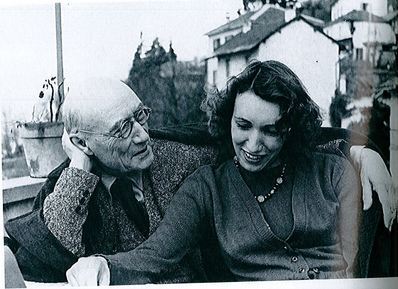André Gide and Catherine Gide
By ADRIAN TAHOURDIN
Catherine Gide, the daughter of André Gide, and probably the
last surviving link to early-twentieth-century French literature, has died at
the age of ninety. Some will no doubt be surprised to read that the writer, who
made his homosexuality public, had a daughter at all (she was his only child).
Catherine was born in 1923, when Gide was in his early fifties.
Gide had married his cousin Madeleine Rondeaux in 1895. In
his autobiography Si le grain ne meurt, Gide wrote "Mon amour pour celle
que j'avais décidé d'épouser me persuadait de ceci: qu'elle avait besoin de
moi, si moi je n'avais pas besoin d'elle, de moi spécialement, pour être
heureuse" (My love for the woman I had decided to marry convinced me of
this: that she had need of me, even if I had no need of her, of me specially
in order to be happy). As is so often the case when Gide writes about himself (and
he did so a great deal), it results in questionable sentiments beautifully
expressed – carefully calculated self-revelation dressed up as naked
confession.
The (unhappy) marriage was unconsummated and it was in the
early stages of it that Gide properly discovered his homosexuality – an
awakening that led to books such as L'Immoraliste and Les Nourritures
terrestres. He took up with the very much younger Marc Allégret, the son of a
family friend and later a filmmaker, with whom he travelled widely, including
to the Congo: Gide's Voyage au Congo, in which he denounced the brutality of
Belgian colonialism, is one of his best books.
The relationship that produced Catherine was with Élisabeth
("Beth") Van Rysselberghe, the daughter of the Belgian painter Théo Van
Rysselberghe, who was a friend of the writer. Théo's wife Maria was one of
Gide's closest confidants. Élisabeth had been Rupert Brooke's lover. She
travelled frequently in company with Gide and Allégret. And brought up their
daughter.
André Gide with his daughter Catherine Lambert, Lake Maggiore, 1947
In his fine biography of the writer (1998), Alan Sheridan
relates how Gide gave Catherine her first piano lesson when when she was six
and how he would read to her from the 1,001 Nights.
According to Sheridan, Gide had to adopt Catherine when, in
1938, he sought to have her recognized officially as his daughter – "because she was the child of an adulterous relationship, 'recognition'
would have no legal binding". It's clear from Sheridan's biography that
Gide held his daughter in great affection: "he had no wish to live with
her, but he wanted to be on hand, to supervise her progress and give her the
benefit of his tuition".
Again Sheridan: "Catherine interested Gide to the
extent that she showed a desire to be educated by him: the pedagogue/pederast
would make allowances for her sex. The eighteen-year-old Catherine was now a
jeune fille en fleur, one who showed no interest whatsoever in her father's
work and only perfunctorily in matters intellectual".
In his voluminous Journals (which Gide himself regarded as
his most lasting work), he writes on July 26, 1941: "I came away
delighted from Catherine's dancing class, which I have just attended". In
what must rank as one of the more inappropriate juxtapositions in print, he
goes on: "Were I a ballet-master, I should go and recruit on the beach
some of those little Italians (perhaps French boys) with tanned bodies whom I
was watching yesterday . . . and whose elegant and rhythmical way of swimming I
was admiring. Trained in dancing, they would seem so provocative that, out of
regard for public morals, no one would dare to 'produce' them".
Later, he writes, "I am rereading Genesis for
Catherine's intention" (one can picture the high-minded solemnity). And
then: "Catherine might have bound me to life; but she is interested only
in herself – and that does not interest me . . . . I had rejoiced immoderately
over those lessons I was preparing to give her in Nice . . . . All her time is
taken up with other lessons (dancing, singing , elocution), which merely
directs her attention to herself".
But Gide approved of her choice of marriage partner in 1946,
Jean Lambert, who, according to Sheridan, was "an academic specialist in
German and English".
Sheridan writes that when visited by Dr Delay in his
final days Gide lamented "I'm afraid that my sentences might become
grammatically incorrect" (Gide died in February 1951).
(What strikes one particularly from Sheridan's biography is
the staggering amount of movement in Gide's life, right up until his final
years – he never seems to have stayed in one place for long – from the early
years of vagabondage across North Africa to . . . "Gide and the Lamberts
then moved out to an hotel at Sorrento" . . . .)
Catherine became a true keeper of the flame for her father's
work, overseeing its appearance in the prestigious Pléiade series. In 2007 she
set up the Fondation Catherine Gide whose resources she made available to
writers and researchers (The Fondation have published a death notice in Le Monde for April 25).
She also wrote a foreword to the posthumous Le Ramier (woodpigeon), which was
published in 2002 and recounts a sexual encounter between the writer and a
young farm boy. She revealed that she had found among her father's papers
"a short erotic novella, dated 1907 and titled The Woodpigeon". Later
she writes "This short text is full of joie de vivre" – "Toute
perversité en est totalement absente".
Peter Stothard's Blog
- Peter Stothard's profile
- 30 followers




